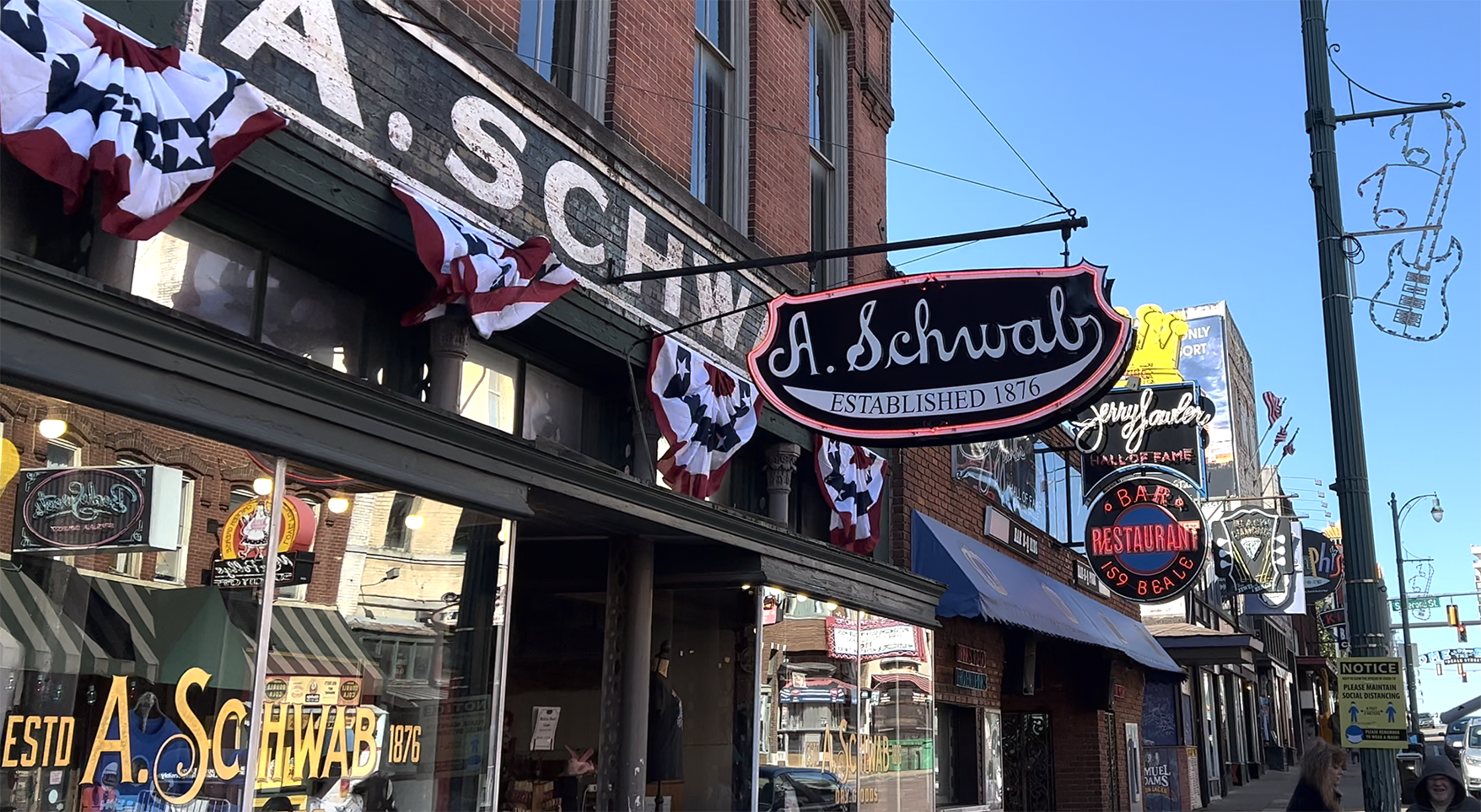The store’s Brass Note set for ceremony Saturday, May 6 at 1:00PM on the Blues Stage in Handy Park has been postponed
A. Schwab Dry Goods, Beale Street’s most historic and only remaining original establishment, is set to receive a long-awaited Beale Street Brass Note during the first weekend of Memphis in May.
The ceremony is set for 1:00 PM Saturday, May 6, on the Blues Stage in Handy Park along Beale Street. Among those on hand to receive the Brass Note will be Elliott Schwab, son of the late Abe Schwab and representing the fourth generation of the Schwab family to work in the famous store. Tony Kail, store employee and hoodoo curator, and author of A Secret History of Memphis Hoodoo, will speak on behalf of the store.
Store manager Teri Cox said, “This (honor) is all about the Schwab family, and honoring their legacy and importance to their heritage on Beale Street. We are all excited.”
Firmly rooted today at 163 Beale Street, A. Schwab Dry Goods opened for business in 1876 down the street at 68 Beale (on the north side of the street between S. Front and S. Main). It was originally opened by Alsatian Jewish immigrant Abraham Joseph Schwab in partnership with the Hirsch family, under the name Hirsch, Schwab & Co, specializing in men’s shoes and boots. But over the following ten years the store expanded their retail stock to include clothing, hardware and home appliances.
The Hirsch and Schwab families split around 1886, and Mr. Schwab reopened a new store up the street at 149 Beale under the name A. Schwab. In 1911, Mr. Schwab passed the store along to his sons Sam, Elias, and Leo. They moved the shop to the middle of Beale, to its current location at 163. In 1924, the store expanded into the space next door, at 165 Beale, that had been the home to a Piggly Wiggly grocery store. In the 1980s, as Beale Street underwent restoration and revitalization geared toward tourism, the store followed suit, revising parts of its retail inventory to focus on the tourist trade and adding its Beale Street Museum to its mezzanine level.

After 100 years at 163 Beale, Elliott Schwab and partners sold the business to a group led by the Saunders family, called Schwab Real Estate Co LLC. Under Saunders, the store continued its focus on tourism and followed the store’s motto that “If you can’t find it at Schwab’s, you’re better off without it,” specializing in hats, Memphis-centric clothing and memorabilia, a renewed Memphis vinyl record and books section upstairs, an expanded hoodoo inventory, and other items that can found nowhere else. The new owners also made a few interior upgrades and added a soda fountain into the space that had until 1924 been the home to the Piggly Wiggly.
Throughout the years, the store has played an integral yet unheralded part in desegregation as an establishment that has always been open to patrons of any color and nationality, was once at the center of early Blues record sales, represents the living history of the Southern Jewish immigrant experience, was largely untouched by the 1968 riots during Dr. Martin Luther King’s march for Memphis sanitation workers and after his murder, and as a key holdout during early 1970s urban renewal, played a huge part in saving Beale Street from complete demolition.
In the summer of 2021, StoryBoard Memphis began a partnership with the store and was allowed complete access to the store’s basement archives, part of a larger project to document and tell the complete A. Schwab story in print and on film. In partnership with DIG Memphis, the digital collection of the Memphis Public Library, StoryBoard and DIG are set to release the first set of a few thousand digitized items from the basement to coincide with the store’s receipt of its brass note.
About the Brass Notes: Saluting the legends of Beale Street (from bealestreet.com/brass-notes)
On the page facing chapter one of Beale Black & Blue by Margaret McKee is a 1973 photograph of Nat D. Williams standing in front of the rubble which was once the Palace Theater. The photo sums up the sense of utter despondence the community experienced as a result of the urban renewal program on Beale Street, which left the street boarded up and abandoned. Not only had the booming establishments of the past disappeared, so had a sense of place and pride. The early, failed efforts to redevelop Beale Street gave every reason to believe the once-enlivened community was gone forever.

The key to the street’s successful redevelopment began in the mind of developer, John Elkington, who envisioned attractions and amenities that would connect the street’s rich past with the future. Elkington’s idea for the Beale Street Brass Note Walk of Fame offered this connection, as visitors from all over the world can read the names of the talented people who put Memphis music and Beale Street on the map.
Today there are over 180 Brass Notes that line Beale Street. For a list of all prior Brass Note recipients, visit the website of the Beale Street Brass Notes Walk of Fame.

